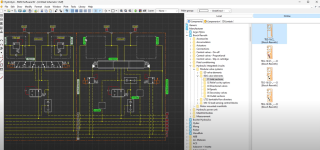Designing a hydraulic system with scalability and ease of maintenance in mind involves a proactive approach. Here are key steps a hydraulic engineer can take to ensure these goals:
Modular Design Approach
- Break System into Modules: Design the system in smaller, interchangeable sections (e.g., power units, valve assemblies, actuator groups) that can function independently. This modularity allows for easier upgrades, maintenance, and future expansion.
- Use Standardized Components: Employ standardized components that can be easily swapped or replaced, ensuring compatibility and availability of spare parts.
Anticipate Future Expansion Needs
- Design for Capacity Flexibility: Build in extra capacity for pumps, reservoirs, and power supplies to handle future demand without needing major redesigns. Include spare ports, expansion valves, or extra connection points to allow easy addition of new components.
- Provide Space for Future Components: Leave physical space in the system layout for potential future components, such as additional pumps, valves, or actuators.
Incorporate Quick-Disconnects and Accessible Connections
- Quick-Disconnect Fittings: Use quick-disconnect couplings for hoses and lines to make it easy to isolate and replace individual components during maintenance.
- Accessible Placement of Components: Ensure that key components like filters, valves, and pumps are placed in easily accessible locations to simplify regular maintenance tasks and reduce downtime.
Utilize Modular Hydraulic Power Units (HPUs)
- HPU Modularity: Create separate, scalable hydraulic power units (HPUs) that can be connected to expand power output. This allows adding or upgrading power capacity without reworking the entire system.
- Independent Power Units: Design sections of the system that can operate independently, so a fault in one area doesn’t affect the entire system.
Take a look a quick configuration of a Bosch Rexroth sectional valve.
Design for Easy Component Replacement
- Standardized Mounting: Use standard mounting brackets and fittings for pumps, motors, and actuators to allow quick removal and replacement of components without custom fabrication.
- Spare Parts Availability: Select commonly available components and ensure critical spares are stocked to minimize downtime during repairs or upgrades.
Implement Redundant Systems for Critical Operations
- Redundancy for Critical Components: Use redundant pumps, valves, and filters in high-demand systems to allow for component failures without system shutdown. This ensures continuous operation during repairs or maintenance.
- Hot Swappable Components: Design for components (like filters and valves) that can be replaced or maintained without shutting down the system.
Install Diagnostic and Monitoring Tools
- Pressure and Flow Sensors: Integrate pressure, flow, and temperature sensors in key points of the system to monitor performance in real time. This helps detect issues early and simplifies troubleshooting.
- Condition Monitoring: Use sensors to monitor the condition of hydraulic fluid (temperature, contamination, viscosity) and key components, enabling predictive maintenance.
Plan for Filtration and Fluid Management
- High-Quality Filtration Systems: Design easy-to-replace filters with accessible filtration units. Multiple-stage filtration can be implemented to extend component life and reduce maintenance intervals.
- Drain Valves and Fluid Sampling Ports: Include drain valves and sampling ports at critical points for easy fluid inspection, draining, and replacement.
Use Flexible Piping and Hoses
- Hose and Tube Flexibility: Use flexible hoses or modular piping to allow for easy rerouting and replacement. Avoid rigid piping systems that require complex disassembly for changes or repairs.
- Minimize Pressure Drops and Line Lengths: Keep piping runs short and direct, ensuring minimum pressure loss and optimizing system efficiency.
Document System and Provide Clear Maintenance Plans
- Create Detailed System Documentation: Provide complete system schematics, component lists, and operating procedures. This helps maintenance personnel quickly identify and resolve issues.
- Develop a Maintenance Schedule: Include a planned maintenance schedule with guidelines for periodic checks, lubrication, and component replacement based on system usage and conditions.
By following these steps, we as hydraulic engineers can design systems that are scalable, maintainable, and adaptable to changing operational requirements, ensuring long-term efficiency and reliability.
